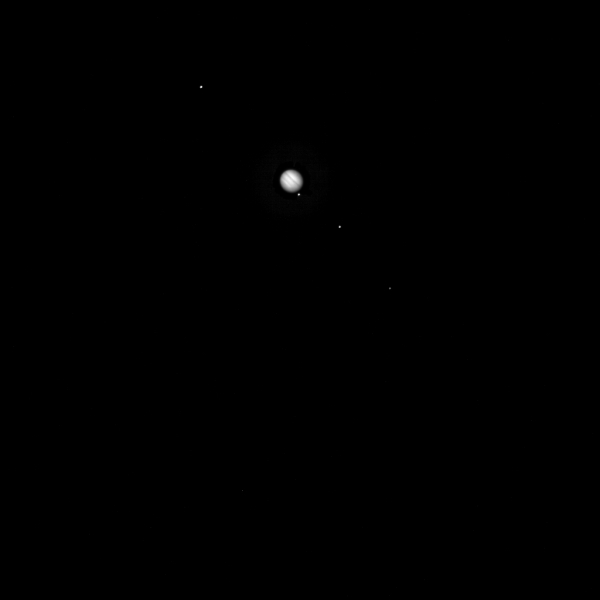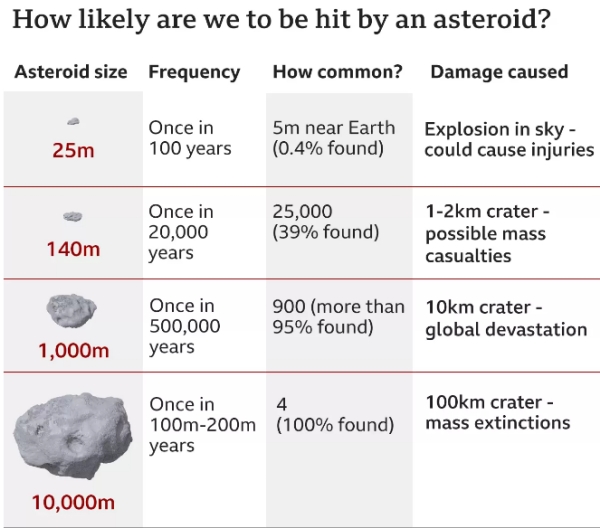Although I had Europa on my mind yesterday, I hadn’t thought to find a connection between the icy Jovian moon and the DART mission. Yet it turns out the Double Asteroid Redirection Test imaged Jupiter and Europa in July and August as the spacecraft moved toward yesterday’s encounter with the binary asteroid Didymos. Controllers used the spacecraft’s DRACO imager (Didymos Reconnaissance and Asteroid Camera for Optical navigation) to examine the visual separation between moon and planet, homing in on variations in the pixel count and intensity as the targets moved across the detector. All this in anticipation of the spacing that would soon be detected between the larger asteroid Didymos and its tiny companion Dimorphos.
Says Peter Ericksen, SMART Nav software engineer at APL:
“Every time we do one of these tests, we tweak the displays, make them a little bit better and a little bit more responsive to what we will actually be looking for during the real terminal event.”

Image: This is a cropped composite of a DART Didymos Reconnaissance and Asteroid Camera for Optical navigation (DRACO) image centered on Jupiter taken during tests of DART’s SMART Nav system. DART was about 435 million miles (700 million kilometers) from Jupiter, and about 16 million miles (26 million kilometers) from Earth, when the image was taken. Two brightness and contrast stretches, made to optimize Jupiter and its moons, respectively, were combined to form this view. From left to right are Ganymede, Jupiter, Europa, Io and Callisto. Credit: NASA/Johns Hopkins APL.
Jupiter and Europa were only part of the extensive testing before last night’s event, involving thousands of pictures of stars. A successful impact was the result. Nice work by the DART team!
It will take time to determine how well the experiment worked, which means measuring the impact’s effect on the tiny asteroid, but the data will help enormously as we continue to assess strategies for adjusting the trajectory of any future objects that may pose a danger to the Earth. We’ll be getting imagery from the Italian LiciaCube spacecraft within days, and further information from ESA’s Hera mission, which will make follow-up studies at Didymos and Dimorphos in four years.
I’ve long believed that efforts like these, necessary to ensure planetary security, will be a powerful driver for space technologies going forward. The threat of a catastrophic collision with an asteroid is small, but the image below, likewise from JHU/APL, gives us a sense of the possibilities. I think of Arthur C. Clarke’s Rendezvous with Rama (1972), where an impact in 2077 causes catastrophic damage to parts of Europe, leading to the development of the protective system of technologies that eventually spots Rama, the enigmatic alien vessel entering our Solar System.

Let’s hope we’re far enough ahead in the game to have the technologies in place to avoid that kind of impact in the first place. DART is an early step in that direction.



Don’t forget the later The Hammer of God that includes 3 impacts in the past:- Oregon 1972, Tunguska 1908, Chicxulub, ~ 65mya, and lastly the fragments of Kali that hit Earth.
In the sources and acknowledgments, Clarke refers back to RWR and the idea of Spaceguard, which drew US attention and NASA’s start to track asteroids nearly a century before the fictional impact in 2077 that initiates THoG’s Spaceguard. One can only wonder what Clarke would say approvingly about DART. After many years of talking, this is the start of serious asteroid deflection for planetary defense, although it will only work for well-tracked asteroids years in advance. We will need more forceful measures for unexpected impacts, like Chelyabinsk, perhaps Lubin’s DE-STAR laser arrays coupled with more complete inner system tracing.
I’m currently reading Grinspoon’s Earth in Human Hands: Shaping our planet’s future in which he includes planetary defense against rare asteroid or comet impacts as desirable actions we can take to ensure Earth’s continued habitability. I will be looking out for any comment on DART by him.
We seem to be a reprise of the 1960’s “space boom” that was partially supported by a buoyant economy. This collapsed in the 1970s as the global economy retreated in the face of oil-shock-induced inflation. I worry that we may be facing something similar again, with a similar retreat from space activities, even though private space is now more established, but still reliant on government support.
Good reference re The Hammer of God. Also, the Grinspoon book is superb, and I was delighted to see his references to planetary defense.
I’m a huge fan of David Grinspoon and have enjoyed all of his books, his “Lonely Planets” being my absolute favorite.
I admit… I had a skeptical eye at first reading “Earth in Human Hands” because I was muttering under my breath “Oh man! Now even David has swallowed that climate change Koolaid, dammit”.
But David presents his case uniquely….. and convincingly ….and stays away from the toxic politics, and I appreciate that. There’s an honest look at going green COST OF BENEFIT vs RISK PROBABILITIES…… which we never hear on them divisive and agenda driven biased news sources. And which we certainly have should have done, just considering the current geo-political situation and cost of living. Refreshingly, climate change is not the sole focus of this book, nor should it be! There are many threats we must face up to and overcome or become extinct ……or at best, that may challenge a long term stable civilization.
Thank you David!
You might be interested in these posts covering David’s book:
SETI in the Anthropocene
https://centauri-dreams.org/2016/11/21/seti-in-the-anthropocene/
Looking for Technosignatures
https://centauri-dreams.org/2016/11/22/looking-for-technosignatures/
The Starship in Our Future
https://centauri-dreams.org/2016/11/23/the-starship-in-our-future/
” … the visual separation between moon and planet, homing in on variations in the pixel count and intensity as the targets moved across the detector. All this in anticipation of the spacing that would soon be detected between the larger asteroid Didymos and its tiny companion Dimorphos.”
the tiny companion asteroid Dimorphos, was certainly not apparent ( at least to me ) at 7000 mi. distance during yesterday’s encounter
Amid the excitement of seeing something as dramatic as this, had a couple of background questions. Maybe others have wondered too.
1. In the past we have already engaged in such target practice: with comets. And they didn’t have much structural tenacity. One could imagine striking Didymos like hitting a cue-ball with an undersized cue stick. Or you could imagine it like hitting a more feathery object through which DART could fly largely unimpeded – in as far as transferring momentum. And that would be closer to what one would expect if it encountered a comet.
2.Despite having met a party of PI’s at an annual Lunar and Planetary Science Conference about 3 or 4 years, I neglected to ask how the DART probe would be accelerated to the impact speeds with which it
encountered ( sic?) Dymorphos, quoted on the radio as about 14,000 mph.
Reviewing the mission, perhaps it was on account of coming to the wrong impression, something like Dawn at Ceres but with a neighboring moon: Imagining DART in rendezvous with the binary asteroid system, surveying it in proximity and capture into orbit.
Not so. This was a repeated flyby in heliocentric orbit. There was a flyby in 2021 and in this current one, the DART vehicle was released.
Consequently, most of the DART powered flight was terminal guidance to the target. Otherwise, if the bus vehicle had been in orbit too, to achieve the terminal velocity, there would have been need for a hefty
chemical rocket stage.
Maybe next time.
In a way, kinetic energy associated with raw inertia is the most powerful form of energy. One can imagine an asteroid accelerated to a Lorentz factor of 101. The invariant mass specific kinetic energy of the body would be equivalent to 100 times its invariant mass.
I am not sure what such huge mass specific kinetic energies are good for except that perhaps they could be harnessed somehow to propel a spacecraft almost to the speed of light really rapidly.
Regardless, in the mean-time, we have perhaps some new options at deflecting potentially deadly asteroids per the DART mission demonstration. Pretty cool stuff.
I saw in the TV News, I think it was CBS or ABC that we could use an atomic bomb to deflect the larger asteroids, but only if the explosion was near them and not on them which I assume might break it up into smaller more numerous fragments which still might hit us.
I believe the TV news item was correct.
I ran the numbers to determine that the energy released in an exploding W-88 nuclear warhead with yield about 475 kilotons produces enough energy to melt a silicate or iron-nickel asteroid roughly 100 meters in diameter. To completely vaporize the asteroid, we would need something a little bigger. However, a stand-off nuke a distance away from the asteroid might vaporize a surface layer which would then explosively rebound and give the asteroid a good push. Of course, nuclear explosives can come in just about any yield although more powerful nukes will have greater mass in general than smaller ones.
DART impact gave asteroid Dimorphos a debris tail thousands of miles long (stunning photo)
https://www.space.com/dart-asteroid-impact-debris-tail-photo?utm_campaign=58E4DE65-C57F-4CD3-9A5A-609994E2C5A9